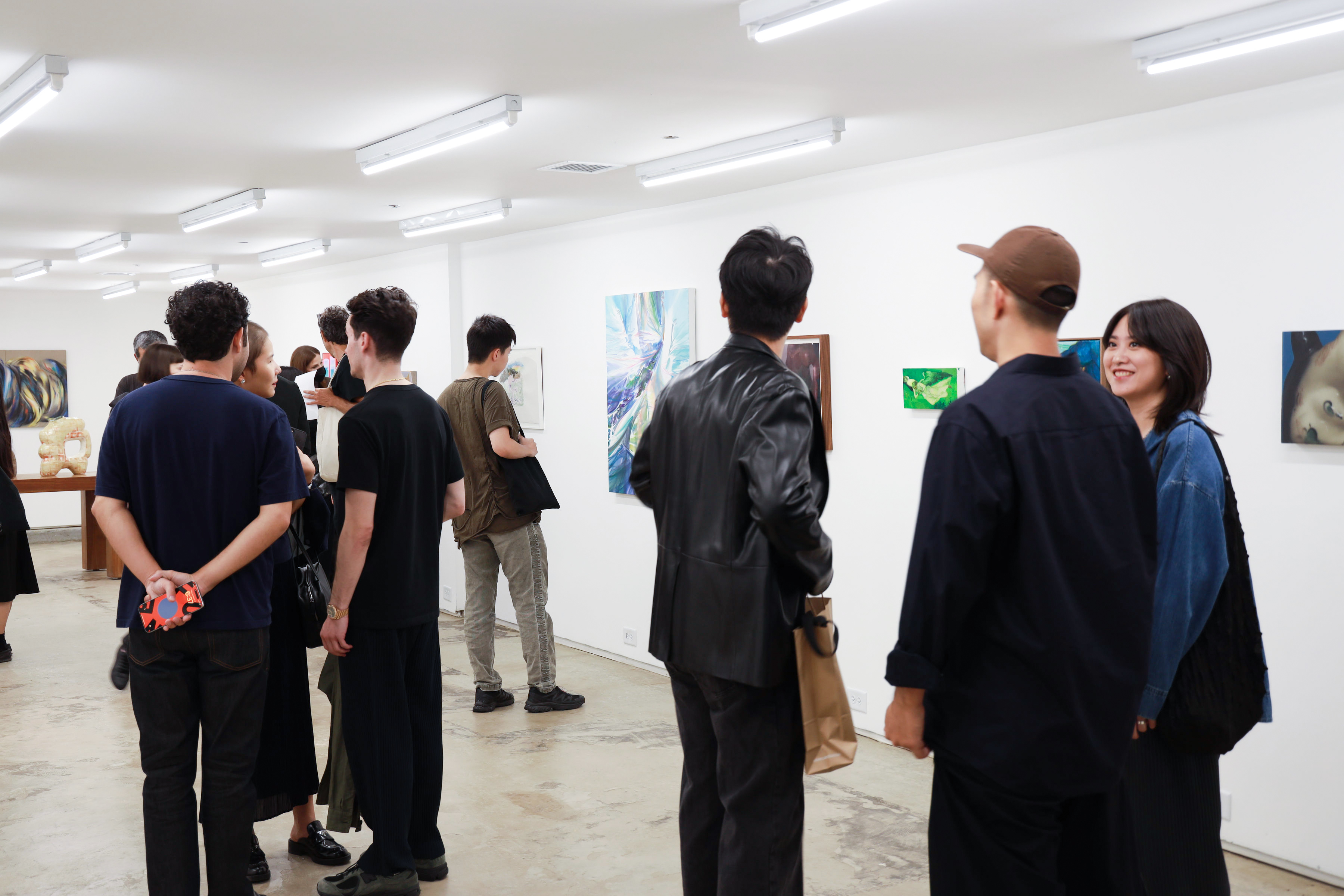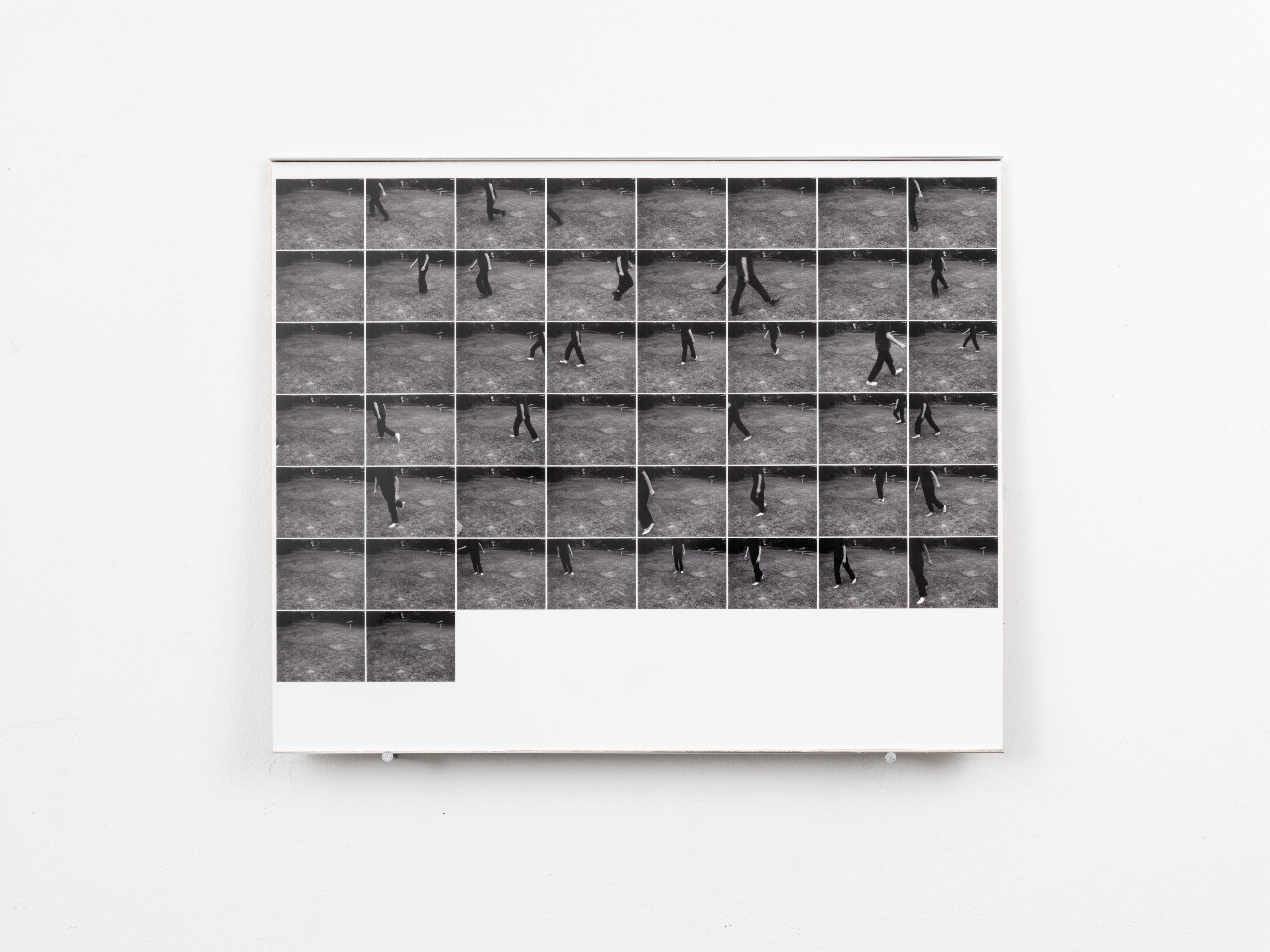Anomture is an inherently paradoxical word, both fragmentary and unitary. The amalgamation of anatomy and nature implies, through anatomy, the study of the human body—its fragmentation in an attempt to figure out how it works. However, through nature, it implies an untouched, Edenic state of world, where nature works as one, flowing unity. This question of fragmentation versus collective unity is one that appears again and again in the works of Hunter Amos, an Australian artist based in New York. He has recently shown at NADA Art Fair and is currently at Strada’s Black Star exhibition in Soho. In January and February of this year, Amos held Rough Hold, a solo exhibition at Anna Zorina Gallery. The exhibition was featured in the New York Times, who described it as having the ‘wisdom’ of an established artist. One of the paintings, called Anomture, features two male forms entangled within one another, but also within a network of vine-like tendrils. The men take on the same brown hue of the vines, and whether they are blissfully happy or torturously consumed by the natural world is unclear. However, in the context of the exhibition as a whole, which explores different interpretations of self, nature, and society, Anomture allows its viewers to conceive of a version of humanity that isn’t above or separate from nature, but part of it. Across the exhibition, the viewer is taken on a radical ecological journey of self-conception.

Art tends to respond to the crises of its time. For modernist artists, one of these was war, and the literal and emotional fragmentation of bodies that came with it. A classic example is Picasso’s Guernica. The gargantuan artwork is nearly four by eight metres, and depicts the bombing of Guernica, a city in the Basque region of Spain. It is devoid of colour, as though, through the violence of war, vibrancy has been driven away. When you look at the work’s overwhelming greyness, it feels as though your ability to view colour itself is stripped away. An aspect of your senses has been removed, leaving you fragmented. The people and animals depicted are also fragmented, with disjointed features slightly out of kilter, their anatomy skewed, and their bodies pierced through by harsh, mechanical lines. It both responds to the war-time crisis of its day and creates a crisis in art. Ever since Guernica and the wider modernist movement, art has attempted to further fragment, even to self-destruct. The works of performance artists such as Yoko Ono, for example, eschew materiality altogether. Ono’s Cut Piece seeks to fragment even what it means to be human—the performance sees her sitting quietly as a succession of strangers cut pieces of clothing from her body. If clothes are the costumes we don to demarcate ourselves from the natural world and from each other, Cut Piece begins to break down these boundaries. The sense of loss in work like Ono’s responds to that portrayed in Guernica, highlighting the instability of the human. Since the modernist movement, art has portrayed humanity as infinitely fragile, even immaterial. Without clothes and in silence—without language—Ono highlights that the individual is indistinguishable from the primordial chaos of nature.

Amos’ artworks fit seamlessly into this conversation. Whilst Anomture’s figures are almost indistinguishable from the world around them, his series, Self-Depict, makes modern fragmentation its own. Each of the artworks in this series are made from enormous slabs of concrete, and depict struggling human figures with them. Self Depict NY 3, for example, shows a person folded nearly in half by the concrete that entraps him. The figure is of a warm yet muted bronze colour, and his body is fragmented by flowing, intersecting lines. This warmth and fluidity contrasts sharply with Picasso’s steely greys and mechanical fissures, yet the concrete frame around the body bears similarities to the triangular blocks in Guernica. The human body is fragmented, but this isn’t the central violence of Amos’ piece. That comes instead from the crushing weight of concrete upon the figure. Picasso’s violence is transmuted from the body to the structures that confine it. In using concrete, a material synonymous with the city-scape, to crush the figures in Self Depict, Amos sets the viewer up to consider not the violence of Picasso’s wars, but that of the perceived war between humanity and nature.

However, the concept of a war between man and nature comes with an inherent binarism—a structure Amos’ work continually challenges. In Self Depict NY 3, it isn’t nature that is crushed by concrete, but the human body. The colours of NY 3 could either suggest an industrial copper or an earthy brown, calling into question humanity's position between the industrial world we have created and the natural one we are born from. This intersection is taken even further in Self Depict NY 6, which, instead of using brown tones, uses subtle greys, greens, and blues. These colours are reminiscent of nature, the strands of green like pondweed, the cool blue like river-water. The figure is both human and nature, like a classical river god, but the pale figure fades away and gets lost in the grey concrete background. Humanity and the natural world are quietly consumed by human creation—the real binary is not between man and nature, but between the organic and the artificial.

However, the boxes in Self Depict are not infallible. They each hold cracks, suggesting the possibility of breaking free. When this happens, the individual may not be so individual at all. They have lost the boundary that separates them from the collective, and the loss of these boundaries is forefronted by Amos’ Of Self, Man. In juxtaposing ‘self’ with the collective connotations of ‘man’ as in ‘mankind’, the very idea of the self is questioned. Of Self explores this question in its depiction of seven men. Each is drawn in similar brown tones as those in Self Depict, and are arranged in chaotic fashion—doubled over, on hands and knees, and falling about. With fists clenched and in a crouched position, the figure on the bottom left of the image appears animalistic, if not monstrous. In fact, none of the characters appear quite human, if only due to the fact that they are almost indistinguishable from one another. Arms link with arms, it isn’t clear whose feet belong to who, or whether or not the man on the bottom right has an arm growing out of his shoulder. Like in Guernica, the individual is violently fragmented. Yet, while Of Self does display violence on first sight, the monstrousness of the man on the bottom-left as a case-in-point, the work is oddly collaborative. The figures link arms across the image and it’s unclear whether the men in the middle at the top of the painting are glaring at each other antagonistically, or gazing like lovers. The man on the top right appears deep in thought. Furthermore, whilst the fragmented anatomy of the figures in Self Depict is clear and defined, the anatomical lines of Of Self, are even softer, looser, and less distinct. Through escaping the concrete confines of Self Depict’s isolationist individualism, the collective men of Of Self are softly and fluidly conjoined.

With the crisis of the individual reconceptualised as not being a crisis at all, Amos’ oil painting, In Forthest, can begin to further the breakdown of the human-nature binary. Humanity can move from an individual, to a collective, to a part of nature itself. The painting depicts a man’s torso with a tangle of vine or snake-like markings instead of a head. The effect is of a faceless Medusa. Yet, with no face, and hands together as though tied, the man in the painting is robbed of individualism. He is indistinguishable from the natural world that consumes his face, and his tied hands suggest an inability to take any action against this. Yet, the body is more defined and solid than any of the bodies discussed so far. It is more real, and more human. The amalgamation of human and nature is presented as amplifying human solidity, rather than breaking it down. The detailed and precise painting of the torso is a far cry from the fragmentation of either Self Depict or Of Self, but the mess of lines in place of a head seems like a step along from the fluid intermingling of bodies in the latter. Furthermore, whilst the tangled head seems consumed by the idea of forest, a face is indistinctly visible. It looks like a green man, tying it to conceptions of a person that is neither human nor nature, but something in between. The body is individual, but the mind, like the intertwining, not-quite-human figures in Of Self, is part of a supra-human collective.
And so we return to Anomture. The vine-like swirls that threaten to consume the men are strongly reminiscent of those that consume the mind in Forthest. With strong, non-fragmented anatomy, the men are solid and assured. Yet they fold into one another—their heads are almost conjoined. An extra hand appears from the top-right as though from nowhere, and the tangled background of the painting appears in places to pull its very essence from their flesh. The men are indistinguishable from nature and from one another, yet they appear to dance. In contrast to the concrete-crushed figures of Self Depict, the men in Anomture are happily at one with the world and one another. In this depiction, the viewer can imagine a response to the climate crisis that emphasises not the individual, but collective action. The self is reconceptualised as a part of a holistic natural system—as American poet Walt Whitman once wrote, ‘I am large, I contain multitudes’.
-------------------------------
Connect with Hunter Amos on: Instagram






